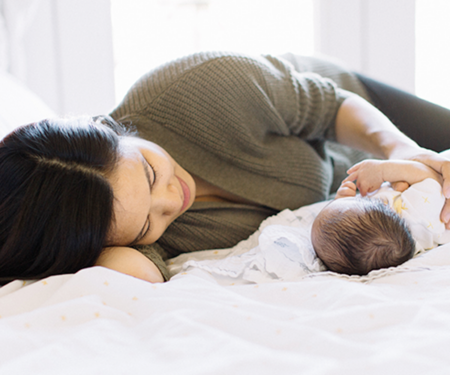Ready to stop contact napping? A sleep specialist shares the steps
If your baby will only fall asleep in your arms, you're not alone! Here's how to make nap time work better for you.

Jacob Lund/Shutterstock
There aren’t many things sweeter in motherhood than being able to snuggle your baby close while they sleep. It’s often here that you are able to slow down and soak in these fleeting moments that we all know pass by so quickly. Contact napping is a beautiful thing—not just for you, but also for your baby.
Defined as when your baby sleeps on your chest or snuggled up next to you, contact napping can bring many benefits. There are even studies that show the importance of being in close physical contact with your baby as frequently as possible in the first few months of life. Doing so can release the hormone oxytocin (the happy hormone), help to regulate your baby’s body temperature, and promote independence and resilience later in life. Contact napping is also typically when your baby is going to get their longest stretches of sleep initially as they adjust to life outside of the womb.
Motherly's Digital Classes
Needless to say, contact napping is good and necessary, but it also can be challenging if this is the only way your baby will sleep. This is especially hard if naptime is the only time you have to knock some things off your to-do list, or do basic things like shower and get ready for the day. This is when being able to set your baby down in their crib to nap or bassinet for a nap would be helpful.
Related: 4 steps to prep your baby for a restful nap
If your baby is currently contact napping and that’s working for you, there is no need for you to make changes if you’re not ready. But if contact napping has gotten to the point where it is no longer sustainable, there are several ways that you can start to practice naps in the crib or bassinet.
5 ways to transition away from contact napping
1. Set up an environment that promotes sleep
Before you set your baby down in a crib or bassinet, make sure that they have a healthy sleep environment. Some things to think about are the temperature in the room, the lighting, noise level and set-up of the room. Ideally, your baby’s sleep space is between 68 degrees and 72 degrees Fahrenheit, is as dark as possible, is quiet aside from white noise and is free of distractions and clutter. A healthy sleep environment is an important ingredient when it comes to promoting adequate naps so you don’t want to skip this step in the process.
2. Help your baby get used to their sleeping space during awake periods
While you don’t want to promote the crib as a place to play, you also want to help your baby feel comfortable there, and sometimes babies reject the crib simply because it is unfamiliar. The more time they spend in this space, the less likely they are to reject it. So try setting your baby in the crib for short periods during an awake window to expose them more and more to this space.
Related: Sleep like a baby: Your expert guide to 12 months of rest
3. Practice putting your baby down in the crib or bassinet once they are asleep
So often parents are focused on trying to put their baby down in the crib completely awake, but this is not something that parents should worry about initially. While your baby might be able to do this at some point, you want to first help them get used to sleeping in the crib. So, putting them down once they are asleep is usually the best way to help them do this. Generally, you want to wait about 10 minutes or so before transferring them to ensure they are fully asleep, and once you lower them in the crib try to do so by placing them on their side first and then gently rolling them to their back.
4. Ensure you are following awake windows and your child’s sleepy cues
Sometimes babies simply refuse the crib because they are overtired and fussy. To avoid this, make sure you are following age-appropriate awake windows, and your child’s sleepy cues to ensure they are being put down at the right time. This is especially important if your baby is taking short naps or rejecting their nap all together.
Related: It’s science: The benefits of nap time on your child’s brain development
5. Finally, keep practicing and don’t give up
If you’re ready to limit contact napping, remember that this is going to take time and it is normal for your baby to reject the crib or bassinet initially. Babies almost always would prefer to be snuggled up on you than on a firm mattress in a crib by themselves. But if the crib/bassinet is never offered, they are going to continue to prefer and expect contact naps. While one or two contact naps per day may still be needed to ensure your baby gets adequate day sleep, you don’t want to give up on the crib if that is your goal. Even if your baby only naps there for 30 minutes, that is still a win and a sign that you are on the right track.
Related: This 5-minute walk-then-sit routine can help your baby fall asleep faster
A note from Motherly
Contact napping is a wonderful way to bond with your baby and help them get some much needed day sleep. However, it’s not right for every baby or family long term, and in some cases may not even be possible.
If you are ready to stop contact napping, or at least limit it, implementing these tips gradually should help. If you find that your baby continues to reject the crib or bassinet, consider reaching out for additional guidance and one-on-one support.
